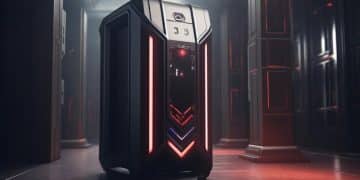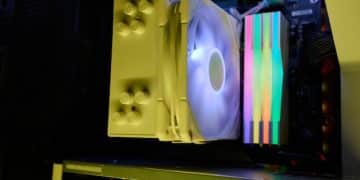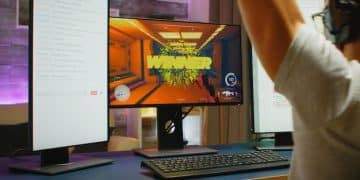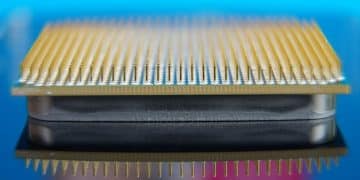Maximize Your Monitor: Upgrade to 144Hz for Competitive Gaming
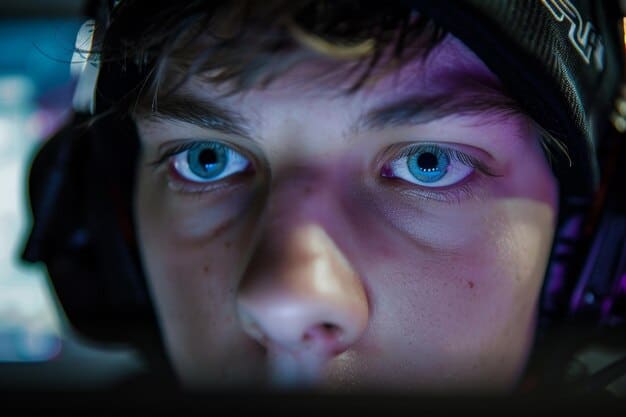
Upgrading to a 144Hz monitor significantly enhances competitive gaming by providing smoother visuals and reduced input lag, offering a crucial advantage in fast-paced titles where every millisecond counts for improved reaction times against opponents.
In the high-stakes world of competitive gaming, every millisecond can tip the scales between victory and defeat. This is where the notion of improving your hardware setup comes into sharp focus, particularly when it comes to visual fidelity. A powerful, yet often overlooked, upgrade involves your display. Specifically, we’ll explore why you should Maximize Your Monitor: Upgrading to a 144Hz Display for Competitive Gaming is not just a luxury, but a strategic necessity for serious players.
The undeniable advantage of higher refresh rates
The refresh rate of a monitor, measured in Hertz (Hz), indicates how many times per second the screen updates its image. A standard monitor typically operates at 60Hz, meaning it refreshes 60 times a second. In contrast, a 144Hz monitor refreshes 144 times per second. This fundamental difference translates into a remarkably smoother visual experience, a benefit that becomes profoundly impactful in the dynamic and fast-moving environments of competitive gaming.
The human eye and brain are more adept at perceiving motion than most people realize. While a 60Hz display might suffice for casual computing and general entertainment, the rapid movements and quick target acquisition required in esports demand a display that can keep pace. The higher refresh rate reduces motion blur and ghosting, making it easier to track enemies, projectiles, and rapidly changing game states. This clarity allows for quicker recognition of threats and opportunities, forming the bedrock of superior decision-making in critical moments.
Understanding refresh rate versus FPS
It is important to distinguish between refresh rate (Hz) and frames per second (FPS). FPS refers to the number of frames your graphics card can render per second. While a high FPS is desirable, your monitor’s refresh rate dictates how many of those frames your screen can actually display. If your GPU renders 200 FPS but your monitor is only 60Hz, you will effectively only see 60 frames per second. Conversely, if your monitor is 144Hz, it can display up to 144 frames per second, provided your graphics card can consistently deliver that many frames.
- Refresh Rate (Hz): Monitor’s ability to refresh its image per second.
- Frames Per Second (FPS): Graphics card’s ability to render frames per second.
- Synchronization: To fully benefit from a 144Hz monitor, your PC needs to consistently output FPS close to or above 144.
This synchronization is key. Achieving a high refresh rate is only meaningful if your gaming rig is capable of pushing out a consistent number of frames that the monitor can display. A powerful CPU and GPU are therefore essential companions to a 144Hz monitor, ensuring that you’re not bottlenecking your visual performance. Without sufficient FPS, the monitor’s potential remains untapped.
Moreover, the subtle improvements in fluidity contribute to a reduction in eye strain during extended gaming sessions. When images are smoother and tearing is minimized, the eyes do not have to work as hard to interpret rapidly changing visuals, allowing players to maintain focus and comfort over longer periods. This aspect is particularly valuable for professional gamers or enthusiasts who spend countless hours refining their skills and competing.
Reduced input lag and improved reaction times
Beyond the visual smoothness, a less discussed but equally critical advantage of 144Hz monitors is the significant reduction in input lag. Input lag refers to the delay between performing an action (e.g., clicking your mouse or pressing a key) and seeing that action reflected on your screen. While this delay might seem imperceptible to the casual observer, in competitive gaming, even a few milliseconds can affect the outcome of an engagement, defining the fine line between hitting a crucial headshot or missing it entirely.
Lower refresh rate monitors inherently introduce more input lag because they take longer to refresh the image displayed. An action performed right after a refresh cycle on a 60Hz monitor will wait nearly 16.67 milliseconds (1000ms/60Hz) for the next refresh cycle to display. On a 144Hz monitor, that wait time is significantly cut to approximately 6.94 milliseconds (1000ms/144Hz). This reduction of almost 10 milliseconds may not sound like much on paper, but it grants competitive players a tangible edge, especially in genres where quick reflexes are paramount.
The science of reaction in gaming
Human reaction time typically ranges from 150 to 250 milliseconds for visual stimuli. Cutting down the display lag, even marginally, means that the visual information reaches your brain faster. This in turn allows your motor commands to be executed more quickly in response to what you see. For games like first-person shooters (FPS) or fighting games, where split-second decisions and precise timing are rewarded, this immediate feedback loop can be a game-changer.
- Faster Visual Feedback: Quicker display updates mean less delay between your action and its on-screen representation.
- Enhanced Precision: Reduced ghosting and tearing allow for more accurate aiming and tracking of fast-moving targets.
- Competitive Edge: Marginal improvements in reaction time contribute to a significant advantage over opponents.
The cumulative effect of these factors is a more responsive and immersive gaming experience. Players often report feeling more “connected” to the game, as their inputs translate almost instantly into on-screen results. This heightened sense of control can lead to increased confidence and improved performance, allowing gamers to react to fleeting opportunities and dodge incoming threats with greater agility. It’s not just about seeing more frames; it’s about feeling the game more directly.

Furthermore, a less noticeable but crucial benefit is the reduction of “micro-stutters” that happen on lower refresh rate monitors when framerates fluctuate. While G-Sync or FreeSync can help mitigate tearing, they don’t eliminate the fundamental latency associated with a slower refresh cycle. A native 144Hz display, even without adaptive sync, provides a far smoother baseline experience, reducing perceived lag and making the game flow more naturally.
Choosing the right 144Hz monitor: what to consider
Transitioning to a 144Hz monitor involves more than just picking the first one you see. Several factors come into play, and understanding them will help you make an informed decision that aligns with your gaming preferences and budget. The market offers a wide array of options, each with its unique strengths and weaknesses.
Panel technologies: TN vs IPS vs VA
The type of panel technology used in the monitor significantly impacts its performance characteristics:
- TN (Twisted Nematic): Known for extremely fast response times and high refresh rates, making them a favorite for competitive gamers. However, they typically suffer from poorer color accuracy and narrower viewing angles.
- IPS (In-Plane Switching): Offers superior color reproduction and wider viewing angles compared to TN panels. While historically slower, modern IPS panels can now achieve high refresh rates and respectable response times, making them a more versatile choice for both gaming and content creation.
- VA (Vertical Alignment): Provides excellent contrast ratios and deeper blacks, offering an immersive visual experience. Response times are generally slower than TN and sometimes IPS, but they strike a good balance between image quality and speed for many users.
Your choice of panel will depend on your priorities. For hardcore competitive gamers where every millisecond counts, TN might still be the go-to. If you value visual fidelity and versatility, IPS has become a very strong contender. VA panels are great for immersive single-player experiences where deep blacks enhance atmosphere, though some competitive players might find their response times less ideal.
Adaptive sync technologies: G-Sync vs FreeSync
Adaptive sync technologies like NVIDIA’s G-Sync and AMD’s FreeSync synchronize the monitor’s refresh rate with your graphics card’s frame rate. This eliminates screen tearing and reduces stuttering, providing an even smoother gaming experience, especially when your FPS fluctuates below your monitor’s maximum refresh rate. It’s crucial to choose a monitor that supports the adaptive sync technology compatible with your graphics card:
- NVIDIA G-Sync: Requires a dedicated hardware module in the monitor, leading to higher costs. Offers excellent performance and reliability, exclusive to NVIDIA GPUs.
- AMD FreeSync: An open standard, implemented via software, making FreeSync monitors generally more affordable. Compatible with AMD GPUs and increasingly with NVIDIA GPUs (using “G-Sync Compatible” mode).
These technologies are major enhancements that complement a high refresh rate. They ensure that even when your frame rate dips slightly, the visual experience remains fluid, preventing jarring visual artifacts. For optimal performance, always pair your GPU with a monitor that supports its respective adaptive sync technology.
Other considerations include screen resolution, with 1080p being the most common for competitive 144Hz panels due to ease of driving high FPS, and 1440p offering a balance of visuals and performance. Ergonomics and stand adjustability are also important for comfort during long gaming sessions, as is connectivity, ensuring your GPU has the necessary DisplayPort or HDMI ports to support 144Hz.
Optimizing your system for 144Hz performance
Simply plugging in a 144Hz monitor won’t magically unlock its full potential. Your entire system needs to be capable of supporting and sustaining high frame rates. Without proper optimization, your powerful new display might be underutilized, leading to a suboptimal gaming experience. This process involves a combination of hardware and software tweaks.
Graphics card and CPU considerations
The two most critical components for achieving high FPS are your graphics card (GPU) and central processing unit (CPU). For competitive gaming, you’ll want to ensure your GPU is powerful enough to render frames at or above 144 FPS consistently in your preferred games at your desired resolution. Modern mid-to-high-end GPUs from both NVIDIA and AMD are generally well-equipped for this task, especially at 1080p resolution.
- GPU Power: Invest in a graphics card capable of consistently rendering more than 144 FPS in your target games.
- CPU Performance: Ensure your CPU doesn’t bottleneck your GPU; a strong multi-core CPU is essential for handling game logic and other background processes.
- RAM Capacity: At least 16GB of DDR4 RAM is recommended for modern gaming to prevent stutters and load times.
While the GPU handles most of the graphical heavy lifting, a capable CPU is equally important, particularly in CPU-intensive games like strategy titles or those with many active players (e.g., battle royales). An underpowered CPU can bottleneck even the most robust GPU, preventing it from reaching its full potential. Ensure your CPU has enough cores andTHREADS to efficiently manage game logic, AI, and other background processes without limiting your frame rate.
RAM also plays a role in overall system responsiveness and frame stability. While 8GB might be sufficient for some games, 16GB of fast DDR4 (or DDR5 for newer platforms) RAM is generally recommended for modern gaming. Sufficient RAM ensures that textures and game assets can be loaded quickly, minimizing stuttering and improving overall fluidity. Opt for RAM with higher clock speeds and lower latencies for better performance.
In-game settings and driver updates
Even with powerful hardware, incorrect in-game settings can severely impact your FPS. Many competitive gamers prioritize frame rate over graphical fidelity. Consider lowering settings like shadows, anti-aliasing, and intricate post-processing effects, as these are often major performance hogs with minimal competitive benefit. Adjusting texture quality, draw distance, and other parameters can allow you to find the sweet spot where visual quality is acceptable, but FPS remains consistently high.
Keeping your graphics drivers updated is non-negotiable. Both NVIDIA and AMD frequently release driver updates that include performance optimizations for new games and bug fixes that can significantly improve frame rates and stability. Regularly check for and install the latest drivers from your GPU manufacturer’s website. Furthermore, ensure your operating system is up-to-date, as Windows updates often include performance enhancements relevant to gaming.
Finally, check your monitor’s settings and ensure it’s configured to run at 144Hz. This often involves navigating to your operating system’s display settings or your GPU’s control panel and manually selecting the higher refresh rate. Sometimes, a monitor might default to 60Hz out of the box, requiring a manual adjustment to unlock its full potential. These seemingly small details can have a profound impact on your gaming experience.
Installation and setup: getting 144Hz running smoothly
Once you’ve chosen your new 144Hz monitor and ensured your system is ready, the next step is connecting and configuring it correctly. This process is generally straightforward but involves a few critical points to ensure you’re getting the most out of your high-refresh-rate display. Overlooking a simple step can result in your monitor not performing at its advertised refresh rate.
Connecting your monitor: DisplayPort vs HDMI
For a 144Hz refresh rate, especially at resolutions like 1080p or 1440p, the choice of display cable is crucial. Not all cables and ports support the necessary bandwidth:
- DisplayPort (Recommended): DisplayPort is generally the preferred choice for 144Hz and higher refresh rates, along with adaptive sync technologies like G-Sync and FreeSync. It has sufficient bandwidth for most high-refresh-rate scenarios, including 1440p at 144Hz or even 4K at 120Hz on newer versions.
- HDMI: While some modern HDMI versions (e.g., HDMI 2.0 or 2.1) can support 144Hz at 1080p or even 1440p, older versions (e.g., HDMI 1.4) may be limited to 60Hz or 120Hz at lower resolutions. Always check the specific HDMI version on your monitor and graphics card, and use a high-quality cable rated for the required bandwidth.
Avoid older DVI cables, as they usually lack the bandwidth for 144Hz at meaningful resolutions. Once connected, ensure the cable is securely plugged into both your graphics card and your monitor. A loose connection can lead to signal degradation or prevent the monitor from detecting the correct refresh rate.
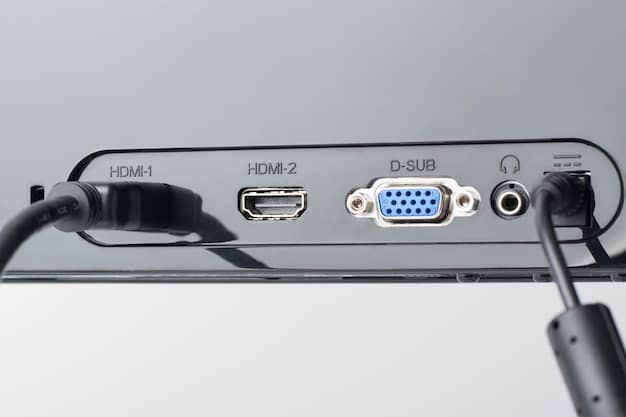
Configuring Windows and game settings
After connecting, the first thing to do is ensure Windows recognizes and uses the 144Hz refresh rate. To do this:
Right-click on your desktop and select “Display settings.”
Scroll down and click “Advanced display settings.”
Choose your monitor from the drop-down menu if you have multiple displays, then click “Display adapter properties for Display [X]”.
Navigate to the “Monitor” tab and select “144 Hertz” (or the highest available refresh rate) from the “Screen refresh rate” drop-down menu. Click “Apply” and “OK.”
If you have adaptive sync (G-Sync or FreeSync), enable it through your GPU’s control panel (NVIDIA Control Panel or AMD Radeon Software). For G-Sync, ensure it’s enabled for full screen or windowed mode, depending on your preference. For FreeSync, ensure it’s enabled in the AMD Radeon Software and often also in your monitor’s OSD (On-Screen Display) menu.
Finally, check the in-game settings for each game you play. Many games have a refresh rate option in their graphics or display settings. Ensure this is set to 144Hz or “Max” to take full advantage of your new monitor. Some games may also have specific settings for adaptive sync or V-Sync; experiment with these to find the optimal balance for your system, remembering that V-Sync can introduce input lag if not managed carefully alongside adaptive sync.
Beyond 144Hz: exploring higher refresh rates and other features
While 144Hz is a sweet spot for competitive gaming, particularly for those upgrading from 60Hz, the market doesn’t stop there. Higher refresh rates, such as 240Hz, 360Hz, and even emerging 500Hz+ displays, are becoming more common. These ultra-high refresh rates push the boundaries of fluidity and responsiveness even further, catering to the most elite competitive players who demand every conceivable advantage. However, with diminishing returns, other features also become increasingly pertinent.
When is 240Hz or 360Hz worth it?
The jump from 60Hz to 144Hz is incredibly noticeable and transformative. The difference between 144Hz and 240Hz is less pronounced but still discernible, especially for professional esports athletes or those with extremely high visual acuity and fast reaction times. The leap from 240Hz to 360Hz and beyond sees even smaller, almost imperceptible gains for the average player. These ultra-high refresh rates are primarily designed for specific competitive titles where milliseconds dictate outcomes, such as Counter-Strike: Global Offensive or Valorant, and require incredibly powerful hardware to drive the necessary FPS consistently.
- 240Hz: Noticeable improvement for elite players, especially in fast-paced FPS games. Requires top-tier hardware.
- 360Hz/500Hz+: Geared towards professional esports scenarios where every millisecond is critical. Diminishing returns for most users.
The cost also scales significantly with higher refresh rates. A 360Hz monitor will be considerably more expensive than a 144Hz model, and the additional investment in a GPU capable of consistently pushing 360 FPS or more adds to the overall cost. For the vast majority of competitive gamers, 144Hz or even 165Hz offers an excellent balance of performance, cost, and accessible hardware requirements.
Other advanced monitor features
Beyond refresh rate, other features enhance the competitive gaming experience:
Response Time: Measured in milliseconds (ms), this indicates how quickly pixels can change from one color to another. A lower response time (1ms GTG – Gray-to-Gray) is crucial for competitive gaming, as it minimizes motion blur and ghosting.
Low Input Lag Mode: Many gaming monitors include specific modes that bypass certain image processing, further reducing input lag. This is often integrated into the monitor’s OSD settings.
Black Equalizer/Clarity Features: Some monitors include settings to brighten dark areas without overexposing bright ones, making enemies in shadows more visible. While some consider this a form of “cheating,” it’s a common feature in competitive gaming monitors.
HDR (High Dynamic Range): While beautiful for single-player games and media consumption, HDR can sometimes introduce latency or complicate color accuracy in competitive scenarios. It’s often disabled in competitive play for predictability and consistency.
Ultimately, a 144Hz monitor hits a sweet spot, providing a massive performance boost over 60Hz displays without the prohibitive cost and extreme hardware demands of ultra-high refresh rate panels. For anyone serious about competitive gaming, it remains an economical and highly effective upgrade that offers tangible advantages in responsiveness and visual clarity, preparing you for the battlefield without breaking the bank.
| Key Aspect | Brief Description |
|---|---|
| 🚀 Higher Refresh Rate | 144Hz offers significantly smoother visuals compared to 60Hz, reducing motion blur and ghosting for clearer action. |
| ⚡ Reduced Input Lag | Faster refresh cycles mean quicker display of actions, enhancing reaction times and precision in competitive games. |
| 🛠️ System Optimization | Requires a capable GPU and CPU to consistently output 144+ FPS for optimal monitor performance. |
| 🔌 Proper Connectivity | Use DisplayPort for best results; ensure correct settings in Windows and game options for 144Hz activation. |
Frequently asked questions (FAQs)
▼
While not strictly “necessary” to play, a 144Hz monitor provides a significant competitive advantage over 60Hz. The smoother visuals and reduced input lag enable faster reaction times and improve clarity in fast-paced scenarios, which can be crucial in competitive environments.
▼
Yes, to fully utilize a 144Hz monitor, your PC needs to be able to consistently output frames at or above 144 FPS in the games you play. This typically requires a mid-to-high-end graphics card and a capable CPU. Simply connecting the monitor won’t yield benefits if your PC can’t render enough frames.
▼
Both G-Sync (NVIDIA) and FreeSync (AMD) are adaptive sync technologies that synchronize your monitor’s refresh rate with your GPU’s frame rate to eliminate screen tearing and reduce stuttering. G-Sync relies on a proprietary hardware module and is generally more expensive, while FreeSync is an open standard, making monitors more affordable.
▼
It depends on the HDMI version. While some modern HDMI versions (2.0 or 2.1) support 144Hz at 1080p or even 1440p, older versions (1.4) often do not. DisplayPort is generally the recommended and most reliable connection for achieving 144Hz and utilizing adaptive sync technologies.
▼
While not a direct cure for eye strain, the smoother motion and reduced tearing offered by a 144Hz monitor can contribute to a more comfortable viewing experience over long periods. Your eyes don’t have to work as hard to process choppy or blurry images, potentially leading to less fatigue during extended gaming sessions.
Conclusion
Upgrading to a 144Hz monitor for competitive gaming is a transformative step that offers tangible benefits beyond simple aesthetics. It’s an investment in smoother visuals, reduced input lag, and ultimately, an enhanced competitive edge that can make a crucial difference in fast-paced, high-stakes games. By optimizing your system and choosing the right display, you can unlock a level of responsiveness that feels intuitive and provides clear advantages over opponents. For serious gamers, this is no longer just an upgrade; it’s an essential component of a high-performance setup.


